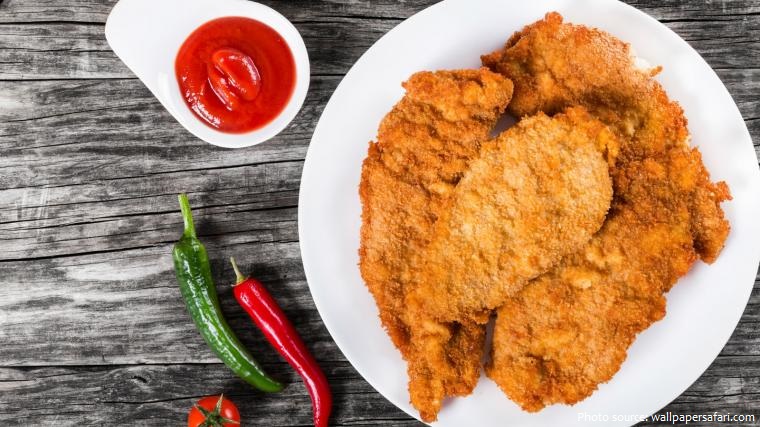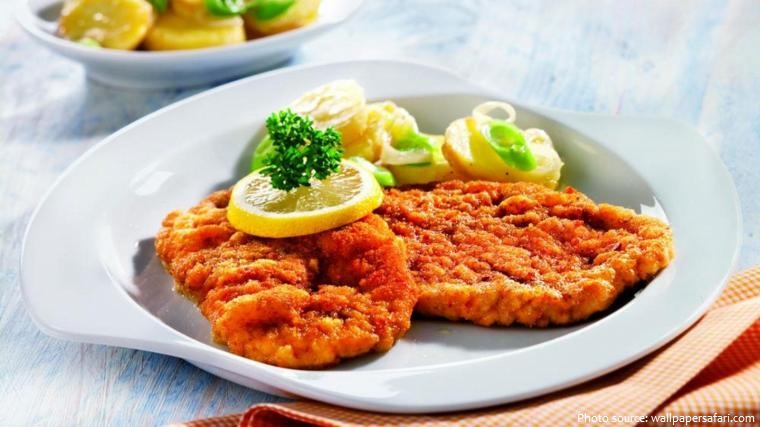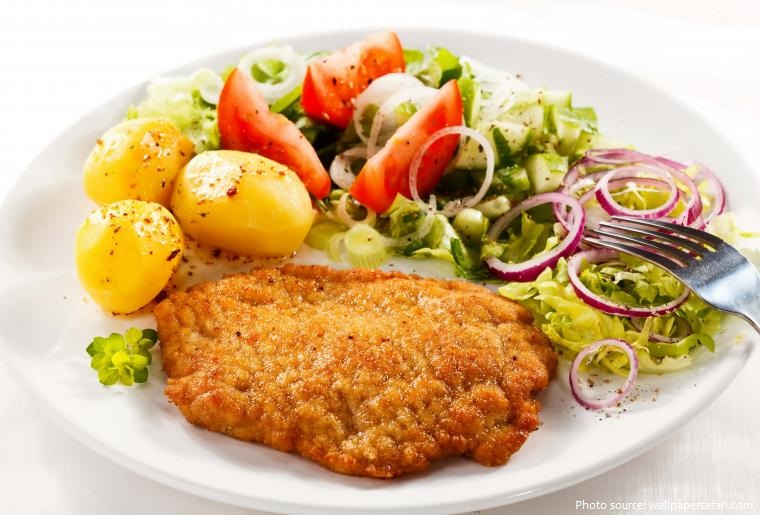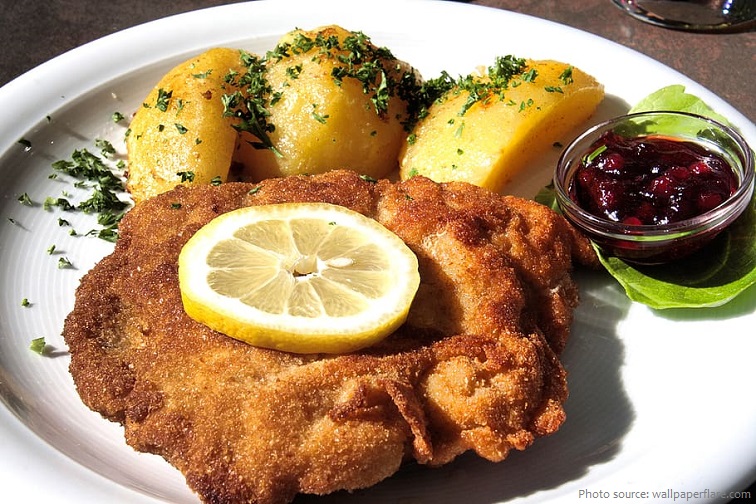
Wiener Schnitzel, sometimes spelled Wienerschnitzel, as in Switzerland, is a type of schnitzel made of a thin, breaded, pan-fried veal cutlet.
It is one of the best known specialities of Viennese cuisine, and one of the national dishes of Austria.
“Wiener” means Viennese (from Vienna) in German. As the name suggests, the Austrians are accredited with the creation of the Wiener Schnitzel. The Wiener Schnitzel was perfected by the Austrians to become the delicious dish known today by every German and found in most German restaurants. However, the origin of the Schnitzel actually goes back to the 7th century Byzantine Empire.

The story goes that the Kaiser Basileios I (867-886 AD) prefered his meat covered with sheets of gold. And what he liked soon became popular with the wealthy. But, this practice became too expensive, so an alternative was created – “yellow gold” (bread crumbs).
Some historians and culinary enthusiast claim that the famous dish was actually first introduced by the ancient Romans who according to the historical data found were the first to start tenderizing meat by pounding it and also the first to roll it in breading and fry it. This data can be found in the oldest existing cookbook written by Apicus dated from the 1st century.
After that, it is suggested that the Romans brought the dish to the Germanic countries and historical data shows that veal became a very popular meat in Northern Italy and on the territory of modern Austria in the middle ages.

The designation Wiener Schnitzel first appeared in the 19th century, with the first known mention in a cookbook from 1831. In the popular southern German cookbook by Katharina Prato, it was mentioned as eingebröselte Kalbsschnitzchen (roughly, “breaded veal cutlets”).
Over the years, the use of bread crumbs in coating meat spread to neighboring lands. It was in Milan, Italy, in the 1800’s where the Austrian Joseph Graf Radetzky discovered a dish called “Costoletta alla Milanese” – a thick veal cutlet, coated with bread crumbs, and sauteed in butter. Radetzky, who was commander over the Austrian troops in Italy (1831 to 1857), reported military, political, and even culinary information back to the Austrian Kaiser.
The term “Wiener Schnitzel” dates to at least 1862.

In 1887, E. F. Knight wrote of a Wiener schnitzel ordered in a Rotterdam cafe, “as far as I could make out, the lowest layer of a Wienerschnitzel consists of juicy veal steaks and slices of lemon peel; the next layer is composed of sardines; then come sliced gherkins, capers, and diverse mysteries; a delicate sauce flavours the whole, and the result is a gastronomic dream.”
In Austria the term is protected by law – “Wiener Schnitzel” assures you of a veal cutlet. Since veal is pricey, a less expensive Austrian alternative uses pork (Wiener Schnitzel vom Schwein). It can also be made with beef, chicken, mutton, pork, turkey, boar and reindeer—any meat that can be cut into thin slices. Just call it Chicken Schnitzel instead of Wiener Schnitzel.
Making Wiener schnitzel is easy. Pound the meat to an even thinness, coat it in flour, then with egg, then with bread crumbs. Fry it to a golden brown and serve with a wedge of lemon and a side of potatoes.

At Restaurant Ofenloch, where Franz Schubert once dined, waitresses deliver generous slices of Wiener schnitzel with crispy, bubbled crusts. Vestibül, a cellar-like hideaway attached to the Burgtheater, serves
a modernized schnitzel, with a crumb coating that has been rendered thin as a hankie.
There had been other dishes in Austrian cuisine, before the Schnitzel, that were breaded and deep fried, such as the popular Backhendl, which was first mentioned in a cookbook from 1719. The Schnitzel was then mentioned in the 19th century as Wiener Schnitzel analogically to the Wiener Backhendl.
While Wiener Schnitzel itself is out of fashion in the US, its spirit lives on in the American dish, Chicken-Fried Steak, a similar recipe made with beef. It was created in the Texas Hill Country by German immigrants, who found themselves with plenty of available beef. There’s more about Chicken-Fried Steak below.

Tonkatsu is a similar, fried pork cutlet from Japanese cuisine, thicker than its European counterparts.
In the Southern Cone, particularly in Argentina and Uruguay, a similar dish is milanesa. It is often served with french fries or mashed potatoes.
In Israel, schnitzel is popular, first introduced by European Jews who immigrated to Israel during the middle decades of the twentieth century. Owing to food shortages at that time and the high cost of meat and veal, and due to kashrut laws that forbid eating pork, the local version was made of chicken breast, which was less expensive. To this day, Israeli schnitzel is made of chicken.